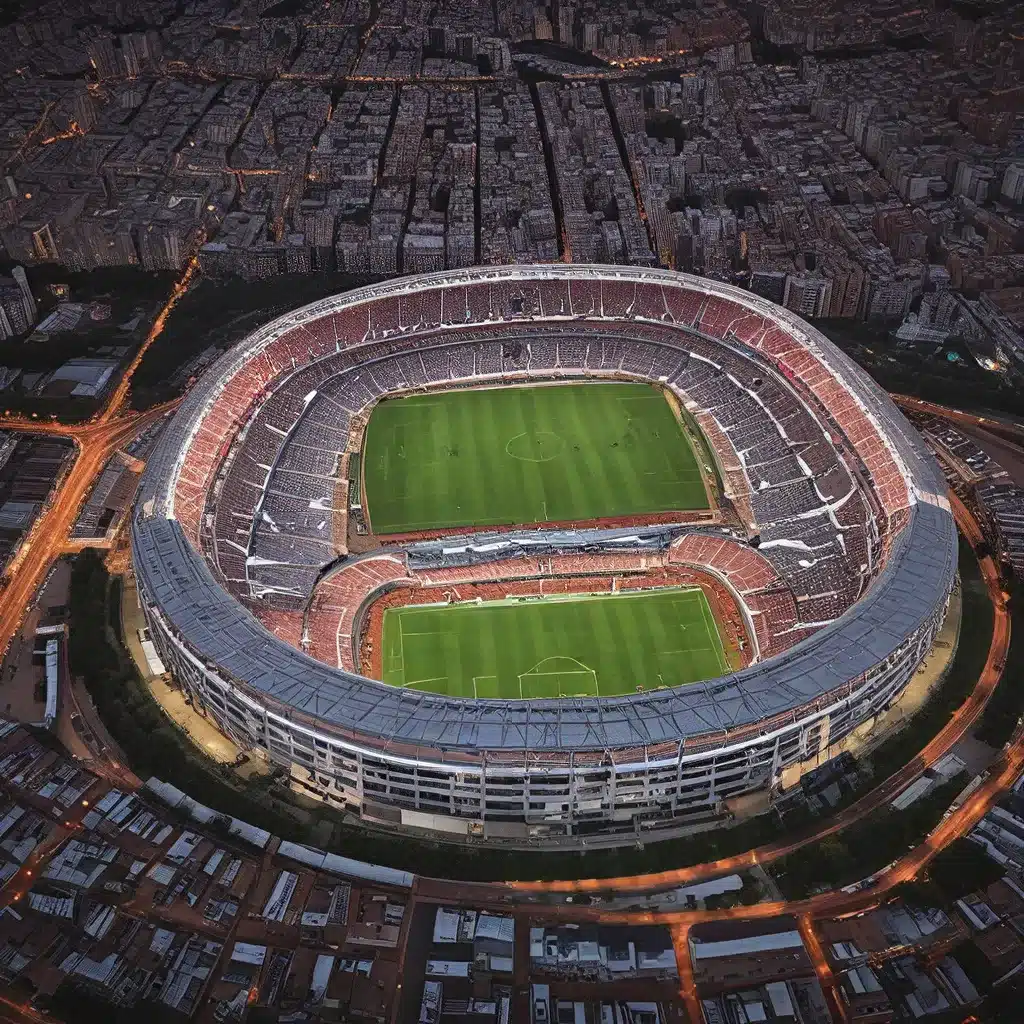
The Iconic Home of River Plate
The Estadio Monumental, also known as the Estadio Antonio Vespucio Liberti, is the home stadium of the renowned Argentine football club River Plate. Situated in the Belgrano neighborhood of Buenos Aires, this colossal arena stands as a testament to the passion and devotion of the club’s fervent supporters, who affectionately refer to it as the “Monumental.”
River Plate, one of the most successful and celebrated teams in South American football history, has long been synonymous with the Estadio Monumental. The stadium’s rich history, architectural grandeur, and the electric atmosphere it generates during matches have all contributed to its iconic status within the global football community.
The Birth of a Football Landmark
The story of the Estadio Monumental begins in the early 1930s when River Plate, then playing at their previous home, the Estadio de Alvear y Tagle, sought to construct a larger and more modern facility to accommodate their rapidly growing fanbase. In 1935, the club acquired a vast plot of land in the Belgrano neighborhood, and the groundbreaking ceremony for the new stadium took place on August 9th of that year.
The construction of the Estadio Monumental was a monumental undertaking, both in terms of scale and significance. Under the guidance of architect Héctor Destéfanis, the stadium’s design was inspired by the iconic Estadio Centenario in Montevideo, Uruguay, which had recently hosted the 1930 FIFA World Cup. The Estadio Monumental was envisioned as a modern, state-of-the-art facility that would not only serve as River Plate’s home but also become a symbol of Argentine football’s grandeur.
The Colossal Transformation
The construction of the Estadio Monumental was a massive undertaking that spanned over a decade, from 1935 to 1938. The sheer scale of the project was awe-inspiring, with the stadium’s capacity initially planned for 70,000 spectators. However, as the work progressed, the design was further expanded, and the final capacity reached an impressive 85,000 seats, making the Estadio Monumental one of the largest football stadiums in Argentina and South America.
The architectural details of the Estadio Monumental were meticulously crafted, reflecting the ambition and vision of its creators. The stadium’s exterior was adorned with a majestic neoclassical façade, complete with imposing columns and elegant arches that evoked a sense of grandeur and timelessness. The interior boasted state-of-the-art facilities, including spacious locker rooms, modern medical facilities, and a vast network of tunnels and corridors that allowed for efficient player and spectator movement.
One of the most striking features of the Estadio Monumental was its iconic central tower, which stood as a beacon for the stadium. This tower, with its distinctive clock and ornate design, has become an integral part of the stadium’s identity and a recognizable landmark within the city of Buenos Aires.
The Estadio Monumental’s Golden Era
The Estadio Monumental’s journey to becoming a legendary football venue was marked by a series of significant events and milestones. In 1938, the stadium hosted its first-ever match, a friendly between River Plate and Boca Juniors, which was attended by a crowd of over 70,000 spectators, setting a new attendance record for the club.
The 1950s and 1960s are often considered the Estadio Monumental’s “golden era,” as River Plate enjoyed a period of sustained success and dominance on the pitch. During this time, the stadium witnessed numerous triumphant moments, including the club’s five Argentine league championships and their 1986 Copa Libertadores victory, the most prestigious club competition in South American football.
The Estadio Monumental also played a significant role in Argentina’s hosting of the 1978 FIFA World Cup, serving as the venue for several matches, including the final, which saw the host nation defeat the Netherlands 3-1 to claim their first-ever world championship.
Renovation and Modernization
Over the decades, the Estadio Monumental has undergone various renovations and modernization projects to keep pace with the evolving demands of football and the expectations of its passionate supporters. In the 1990s, the stadium underwent a major overhaul, including the installation of new seating, improved lighting, and enhanced crowd control measures.
More recently, in the early 2000s, the Estadio Monumental underwent further renovations to modernize its facilities and enhance the match-day experience for fans. These improvements included the installation of a state-of-the-art video scoreboard, the expansion of corporate hospitality areas, and the implementation of advanced security systems.
Despite these changes, the Estadio Monumental has managed to preserve its historical charm and iconic status within the world of football. The stadium’s architectural elegance, coupled with the unwavering support of River Plate’s devoted fanbase, has ensured that it remains a revered and beloved destination for football enthusiasts from around the globe.
A Truly Magnificent Stadium
The Estadio Monumental is a football stadium that transcends the boundaries of the sport, becoming a symbol of Argentine pride and a testament to the enduring passion of its supporters. Its colossal size, architectural grandeur, and rich history have earned it a place among the greatest stadiums in world football.
Beyond its physical attributes, the Estadio Monumental is a stage where the drama and emotion of the beautiful game are played out, with River Plate’s victories and defeats etched into the collective memory of their devoted fans. The stadium’s electric atmosphere, with the chants and cheers of the crowd echoing through its towering stands, has become an integral part of the River Plate experience.
For football enthusiasts seeking to embark on a true stadium journey, the Estadio Monumental stands as a must-visit destination, a temple where the essence of the sport is celebrated and revered. Its legacy as a footballing mecca, a symbol of Argentine identity, and a cherished home for River Plate’s legions of loyal supporters ensures that the Estadio Monumental will continue to captivate and inspire generations of football fans for years to come.

